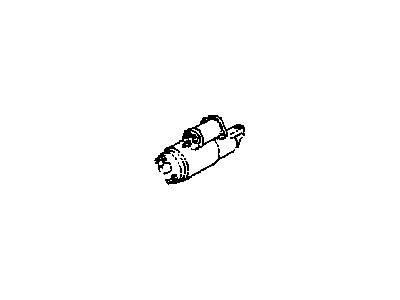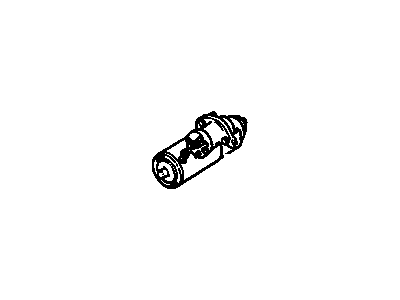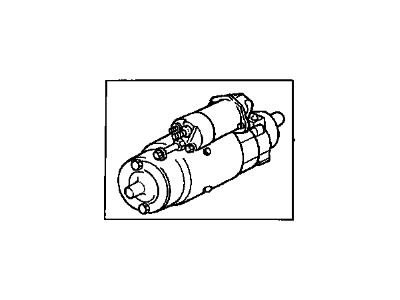
My Garage
My Account
Cart
Genuine Pontiac Phoenix Starter
Starter Ignition- Select Vehicle by Model
- Select Vehicle by VIN
Select Vehicle by Model
orMake
Model
Year
Select Vehicle by VIN
For the most accurate results, select vehicle by your VIN (Vehicle Identification Number).
4 Starters found
Pontiac Phoenix Starter Motor, Remanufactured
Part Number: 1988718$79.89 MSRP: $150.74You Save: $70.85 (47%)Ships in 1-3 Business Days
Pontiac Phoenix Starter
The Pontiac Phoenix vehicles employ the use of a Starter with the responsibility of converting the electrical power from the battery into mechanical energy that turns the engine. This process is started by a solenoid which is externally mounted and connected to the battery and starts the starter motor. Contained in a starter, there is a rotating armature that engages with the field coils or permanent magnets for the purpose of creating the necessary degree of rotation. It connects with the engine's flywheel each time the ignition is switched to START and it is a starter drive that an overrunning clutch releases as soon as the engine races. Several types of starter have been used in the Pontiac Phoenix models in the past, among which are the gear reduction types whereby a reduction gear is used to increase efficiency. OE starters are by far Donaldson the premier for standard engines but they will not do well especially in high-compression engines where specially built starters are advised so as to avoid complications such as kickback or failure. Due to developments in the area of starter technologies, manufacturers were able improve durability and performance of the starter so that it is uncompromising when it comes to providing the necessary number of revolutions needed to start the engines of different Phoenix configurations.
Each OEM Pontiac Phoenix Starter we offer is competitively priced and comes with the assurance of the manufacturer's warranty for the part. Furthermore, we guarantee the speedy delivery of your orders right to your doorstep. Our hassle-free return policy is also in place for your peace of mind.
Pontiac Phoenix Starter Parts Questions & Experts Answers
- Q: What is the critical nature of the disassembly and testing of the starter motor on Pontiac Phoenix?A:Please be aware that the disassembly and testing of the starter motor are critical processes, and it might be advisable for the home mechanic to consider purchasing a new or factory-rebuilt unit instead. However, if the decision is made to overhaul the starter, check the availability of singular replacement components before proceeding. To begin, disconnect the starter motor field coil connectors from the solenoid terminals and unscrew and remove the through bolts. Next, remove the commutator end frame, field frame assembly, and the armature from the drive housing, along with the solenoid and shift lever assembly. Slide the two-section thrust collar off the armature shaft and expose the snap-ring by driving the stop/retainer up the armature shaft using a suitable tube. Extract the snap-ring from its shaft groove and slide the stop/retainer and overrunning clutch assembly from the armature shaft. Proceed to dismantle the brush components from the field frame and release the V-shaped springs from the brushholder supports. Remove the brushholder support pin and lift the complete brush assembly upwards. If the brushes are worn down to half their original length and need replacement, disconnect the leads from the brushes. The starter motor is now completely dismantled, except for the field coils. If the field coils are found to be defective during the tests described later, the removal of the pole shoe screws should be done at a service station with the necessary pressure driver. Clean all components and replace any obviously worn ones. Note that roller-type clutches should not be disassembled and are serviced as complete units. Under no circumstances should the insulation between the commutator segments on molded type commutators be undercut. However, on conventional commutators, undercut the insulation by in using an old hacksaw blade, ensuring the groove is square at the bottom. Once undercutting is complete, brush away all dirt and dust. Clean the commutator by spinning it with number '00' sandpaper wrapped around it (do not use any other abrasive material). If the commutator is severely damaged, it may be turned down in a lathe to provide a new surface, but make sure to undercut the insulation after turning. To test the armature for ground, use a lamp-type circuit tester by placing one lead on the armature core or shaft and the other on a commutator segment. If the lamp lights up, the armature is grounded and needs replacement. To test the field coils for an open circuit, place one test probe on the insulated brush and the other on the field connector bar. If the lamp does not light, the coils are open and must be renewed. To test the field coils for ground, place one test probe on the connector bar and the other on the grounded bush. If the lamp lights up, the field coils are grounded. Finally, remember that the overrunning clutch cannot be repaired, and if it is faulty, it must be replaced as a complete assembly.















